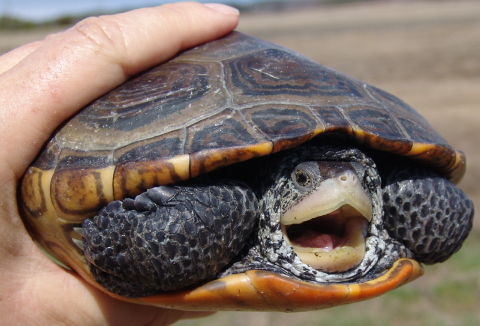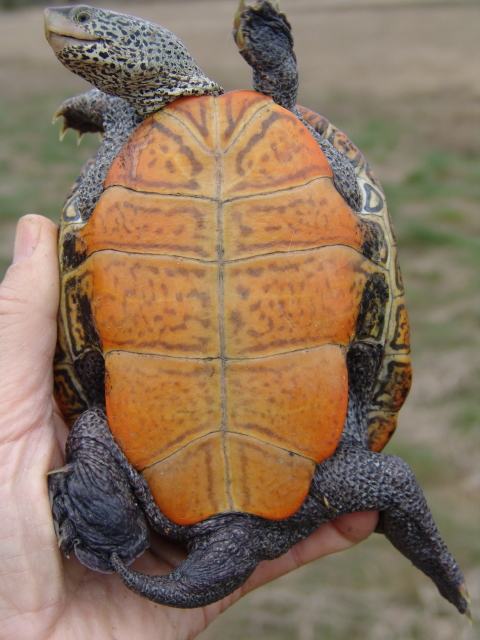Female Terrapin 7086 — Why Is This Girl Smiling?
Yes, SPRINGTIME is finally here for the resident diamondback terrapins of Outer Cape Cod. On Tuesday, Turtle Journal’s Sue Wieber Nourse ventured to the Fresh Brook Run in South Wellfleet wedged between Lieutenant Island to the north and Mass Audubon’s Wellfleet Bay Wildlife Sanctuary to the south. Temperatures finally had risen from the mid 40s to the low 60s with the threat of spring thunderstorms. As Sue waded into the still chilly waters, she was greeted by pairs of smiling terrapins who were much too occupied with each other to realize a turtle researcher had approached with a large collection net.
 Male Terrapin 9867 — Why is This Boy Smiling?
To slightly amend Alfred Lord Tennyson’s oft-quoted sentiment, “In the Spring a young turtle’s fancy turns to thoughts of love.” And turtle fancies were turned in a big way on Tuesday afternoon in Fresh Brook Run. Sue’s first capture was an unmarked mature female terrapin (now #7086) who had been cavorting with previously marked male terrapin #9867, a 10-year-old friend whom we had first seen in the Run in July 2007.
Mating Pair of Diamondback Terrapins
 Male 9270 on the Left; Female 7087 on the Right
Marking a great start to the new research season, Sue captured four pairs of mature diamondback terrapins in the low tide drained Run. Of the four females, one was a recapture: terrapin #9268, a 14-year-old female whom we had first netted in May 2009. The others were first timers who had managed to escape our researchers for the last decade. Of the four males, we had previously seen three in the Run, and one was a first time capture. The adorable couple imaged above clearly illustrate “gender dimorphism” in diamondback terrapins. That’s a fancy way of saying that females are bigger than males, a lot bigger. In maturity, females are four times the mass and twice the length of males.
Besides overall body size (dimorphism), we say there are three ways to distinguish males from females. Male terrapin 9083 demonstrates these characteristics. I ask that anyone too sensitive to hear unexpurgated truths skip to the video below.Â
First, females must have a robust shape to accommodate eggs equal to more than 10% of their body mass. So, we say that females have depth and males are shallow.Â
Secondly, females have distinctly larger heads, while male crania are very small, indeed. There is some casual talk about whether this cranial difference relates to the challenging role females play, or whether females are just smarter than males.  Some say females need more brainpower to negotiate their way over long distances back to their natal birth site, to confront upland predators along the way, and to locate, shape and disguise viable nests.  Males, on the other hand, have a simpler life; they forage, they bask, they mate.
Finally, female terrapins have very small and thin tails that they tuck in closely to their bodies. Males, on the other hand, have large, thick tails that are always prominently displayed. Some less scientific individuals might be tempted to say that males simply have excessive libidos, but you won’t hear that from us.
Terrapins “Going Wild” in Wellfleet Bay
After the brief interlude with Sue, in which they were examined, measured, weighed and marked, these terrapins were released back into the Fresh Brook Run as it rapidly flooded with the incoming tide. Perhaps it is only the eccentric turtler and inveterate poet in me, but I detect a certain skip in their step as these turtles waddle back into the tidal flats of South Wellfleet to resume what comes naturally to diamondback terrapins in springtime.



